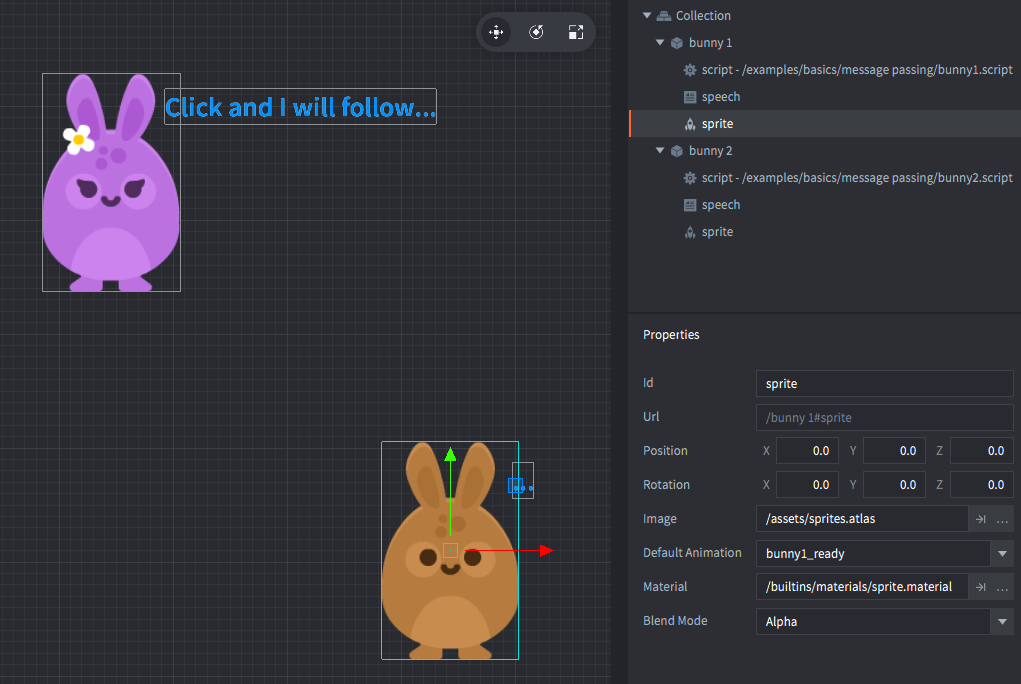Message passing
Setup

Scripts
bunny1.script
local function landed(self) -- <2>
label.set_text("#speech", "I'm there!")
msg.post("bunny 2#script", "i'm there")
end
function on_message(self, message_id, message, sender)
if message_id == hash("go to") then -- <1>
label.set_text("#speech", "Ok...")
go.animate(".", "position", go.PLAYBACK_ONCE_FORWARD, message.position, go.EASING_INOUTCUBIC, 1, 0, landed)
end
end
--[[
1. If someone sends us a "go to" message, set the speech label text and animate to the position supplied
in the message data. At the end of animation, call the function `landed()`
2. This function is called when the position animation is completed. It sets the speech label text and then
sends a message called "i'm there" to the component "script" in the "bunny 2" game object.
--]]bunny2.script
function init(self)
msg.post(".", "acquire_input_focus") -- <1>
self.moving = false -- <2>
end
local function landed(self) -- <6>
self.moving = false
label.set_text("#speech", "Hey, go to the opposite side!")
local pos = go.get_position()
local opposite = vmath.vector3()
opposite.x = 720 - pos.x
opposite.y = 720 - pos.y
msg.post("bunny 1#script", "go to", { position = opposite })
end
function on_message(self, message_id, message, sender)
if message_id == hash("go to") then -- <5>
self.moving = true
label.set_text("#speech", "I'm going...")
go.animate(".", "position", go.PLAYBACK_ONCE_FORWARD, message.position, go.EASING_INOUTCUBIC, 1.5, 0, landed)
elseif message_id == hash("i'm there") then -- <7>
label.set_text("#speech", "Great!")
end
end
function on_input(self, action_id, action)
if action_id == hash("touch") and action.pressed and not self.moving then -- <3>
local pos = vmath.vector3(action.x, action.y, 0)
msg.post("#", "go to", { position = pos }) -- <4>
end
end
--[[
1. Tell the engine that we want to receive input.
2. Store a flag in the current script component instance that tells us if the bunny is moving or not.
3. If user clicked and the bunny is not moving.
4. Send a message to this script component ("#" is shorthand for that) saying "go to" and the clicked position
as part of the message data.
5. If a "go to" message is received, set the speech label text and then animate the position of the current
game object ("." is shorthand for that) to the position send in the message data. When the animation is
done the function `landed()` is called.
6. When `landed()` is called on animation complete, set the label text, then calculate a position on the
opposite of the screen and send a message called "go to" to the component "script" in the game object
"bunny 1". Supplied with the message is the opposite position as message data.
7. If someone sends us a message called "i'm there" we react by just changing the speech label text.
--]] If you want to play with these examples, you can get the project on Github.
Do you want to see more examples? Why not write a few yourself and submit a pull request? We love contributions.
GITHUB